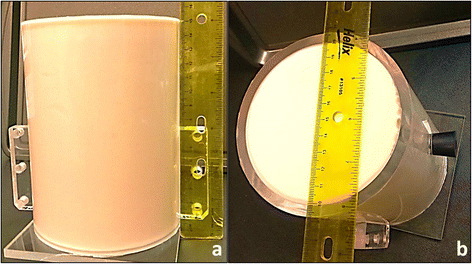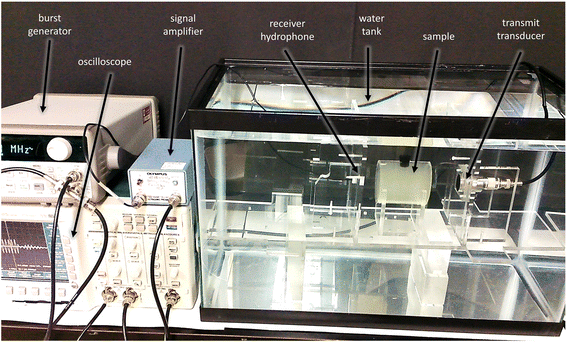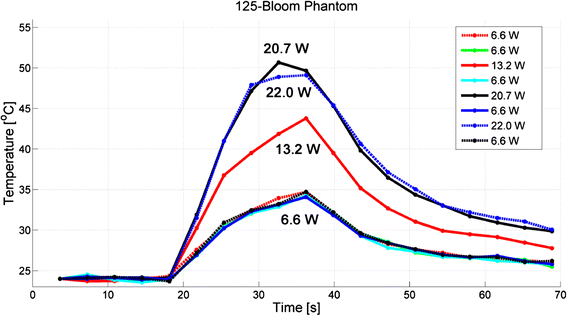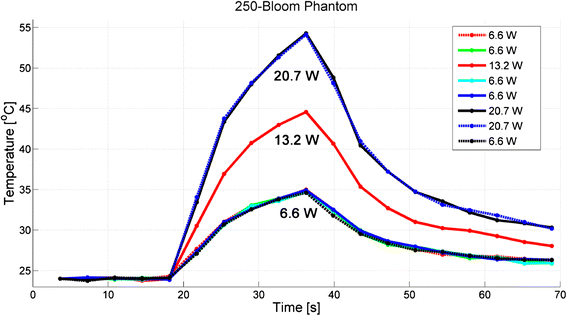Characterization and evaluation of tissue-mimicking gelatin phantoms for use with MRgFUS
- PMID: 26146557
- PMCID: PMC4490606
- DOI: 10.1186/s40349-015-0030-y
Characterization and evaluation of tissue-mimicking gelatin phantoms for use with MRgFUS
Abstract
Background: A tissue-mimicking phantom that accurately represents human-tissue properties is important for safety testing and for validating new imaging techniques. To achieve a variety of desired human-tissue properties, we have fabricated and tested several variations of gelatin phantoms. These phantoms are simple to manufacture and have properties in the same order of magnitude as those of soft tissues. This is important for quality-assurance verification as well as validation of magnetic resonance-guided focused ultrasound (MRgFUS) treatment techniques.
Methods: The phantoms presented in this work were constructed from gelatin powders with three different bloom values (125, 175, and 250), each one allowing for a different mechanical stiffness of the phantom. Evaporated milk was used to replace half of the water in the recipe for the gelatin phantoms in order to achieve attenuation and speed of sound values in soft tissue ranges. These acoustic properties, along with MR (T1 and T2*), mechanical (density and Young's modulus), and thermal properties (thermal diffusivity and specific heat capacity), were obtained through independent measurements for all three bloom types to characterize the gelatin phantoms. Thermal repeatability of the phantoms was also assessed using MRgFUS and MR thermometry.
Results: All the measured values fell within the literature-reported ranges of soft tissues. In heating tests using low-power (6.6 W) sonications, interleaved with high-power (up to 22.0 W) sonications, each of the three different bloom phantoms demonstrated repeatable temperature increases (10.4 ± 0.3 °C for 125-bloom, 10.2 ± 0.3 °C for 175-bloom, and 10.8 ± 0.2 °C for 250-bloom for all 6.6-W sonications) for heating durations of 18.1 s.
Conclusion: These evaporated milk-modified gelatin phantoms should serve as reliable, general soft tissue-mimicking MRgFUS phantoms.
Keywords: Gelatin; MRgFUS; Phantoms; Tissue-mimicking.
Figures





Similar articles
-
Characterization of a soft tissue-mimicking agar/wood powder material for MRgFUS applications.Ultrasonics. 2021 May;113:106357. doi: 10.1016/j.ultras.2021.106357. Epub 2021 Jan 30. Ultrasonics. 2021. PMID: 33548756
-
Development and characterization of a tissue mimicking psyllium husk gelatin phantom for ultrasound and magnetic resonance imaging.Int J Hyperthermia. 2020;37(1):283-290. doi: 10.1080/02656736.2020.1739345. Int J Hyperthermia. 2020. PMID: 32204632 Free PMC article.
-
Acoustic and thermal characterization of agar based phantoms used for evaluating focused ultrasound exposures.J Ther Ultrasound. 2017 Jun 1;5:14. doi: 10.1186/s40349-017-0093-z. eCollection 2017. J Ther Ultrasound. 2017. PMID: 28572977 Free PMC article.
-
Tissue-Mimicking Materials for Ultrasound-Guided Needle Intervention Phantoms: A Comprehensive Review.Ultrasound Med Biol. 2023 Jan;49(1):18-30. doi: 10.1016/j.ultrasmedbio.2022.07.016. Epub 2022 Oct 7. Ultrasound Med Biol. 2023. PMID: 36210247 Review.
-
A Review of Carotid Artery Phantoms for Doppler Ultrasound Applications.J Med Ultrasound. 2021 May 14;29(3):157-166. doi: 10.4103/JMU.JMU_164_20. eCollection 2021 Jul-Sep. J Med Ultrasound. 2021. PMID: 34729323 Free PMC article. Review.
Cited by
-
System-Independent Ultrasound Attenuation Coefficient Estimation Using Spectra Normalization.IEEE Trans Ultrason Ferroelectr Freq Control. 2019 May;66(5):867-875. doi: 10.1109/TUFFC.2019.2903010. Epub 2019 Mar 5. IEEE Trans Ultrason Ferroelectr Freq Control. 2019. PMID: 30843826 Free PMC article.
-
High-quality Agar and Polyacrylamide Tumor-mimicking Phantom Models for Magnetic Resonance-guided Focused Ultrasound Applications.J Med Ultrasound. 2023 Oct 27;32(2):121-133. doi: 10.4103/jmu.jmu_68_23. eCollection 2024 Apr-Jun. J Med Ultrasound. 2023. PMID: 38882616 Free PMC article.
-
An Experimental Protocol for Assessing the Performance of New Ultrasound Probes Based on CMUT Technology in Application to Brain Imaging.J Vis Exp. 2017 Sep 24;(127):55798. doi: 10.3791/55798. J Vis Exp. 2017. PMID: 28994803 Free PMC article.
-
Development and validation of a MRgHIFU non-invasive tissue acoustic property estimation technique.Int J Hyperthermia. 2016 Nov;32(7):723-34. doi: 10.1080/02656736.2016.1216184. Epub 2016 Aug 8. Int J Hyperthermia. 2016. PMID: 27441427 Free PMC article.
-
Focal point determination in magnetic resonance-guided focused ultrasound using tracking coils.Magn Reson Med. 2017 Jun;77(6):2424-2430. doi: 10.1002/mrm.26294. Epub 2016 Jul 15. Magn Reson Med. 2017. PMID: 27418429 Free PMC article.
References
Grants and funding
LinkOut - more resources
Full Text Sources
Other Literature Sources

